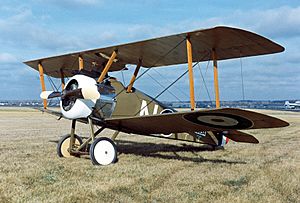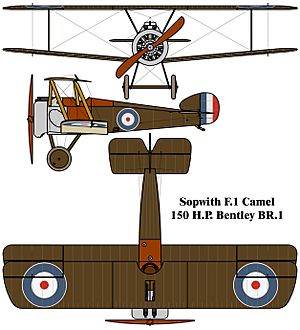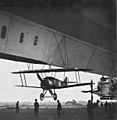Sopwith Camel facts for kids
The Sopwith Camel was a famous British fighter plane from World War I. It was a type of aircraft called a biplane, meaning it had two main wings. Even though it was well-known, it was also famous for being quite tricky to fly!
The Sopwith Camel started flying in June 1917. It quickly became one of the most remembered Allied aircraft of the First World War.
Contents
Flying the Sopwith Camel
Unlike many other biplanes, the Camel was not easy to control. It could turn and move very well in the air. This was because its engine, pilot, guns, and fuel tank were all placed close together at the front. However, this design also made it hard to fly. The engine's power created a strong twisting force, called torque, which made the plane difficult and dangerous to handle.
Pilot Challenges
Pilots soon found that the Camel had a bad reputation. The engine needed very careful control of its fuel mix. If the settings were wrong, the engine could stop working during takeoff. Many pilots crashed because they mishandled the plane when taking off. A full fuel tank also changed the plane's balance, making it even harder. The Camel was also known for spinning out of control easily. If it stalled (lost speed and lift), it would often go into a spin that was very hard to stop.
Camel's Combat Success
Despite its flying challenges, the Sopwith Camel had better guns and performed better in fights than many other biplanes. Its controls were light and reacted quickly. This made it a very effective fighter once pilots mastered it.
The Camel is credited with shooting down 1,294 enemy aircraft. This was more than any other Allied fighter plane during World War I.
Later Use of the Camel
By 1918, newer and faster planes were being built. These new aircraft could also fly better at high altitudes. Because of this, the Sopwith Camel was used less for air-to-air combat. Instead, it became important for attacking targets on the ground and helping soldiers.
In March 1918, flights of Camels played a big role in stopping the German Army from advancing. This showed how useful the plane still was. The Sopwith Camel remained in service until the war ended with the ceasefire (called the armistice).
Images for kids
-
A 1917 Sopwith F.1 Camel at the Steven F. Udvar-Hazy Center
-
A downed Sopwith Camel near Zillebeke, West Flanders, Belgium, 26 September 1917
-
Naval Camels on the aircraft carrier HMS Furious before raiding the Tondern airship hangars
-
The Sopwith 2F.1 Camel used to shoot down Zeppelin L 53, at the Imperial War Museum, London. Notice the twin Lewis guns above the top wing.
-
A replica of a Camel F.1 flown by Lt. George Vaughn Jr., at the USAF Museum
See also
 In Spanish: Sopwith Camel para niños
In Spanish: Sopwith Camel para niños
















